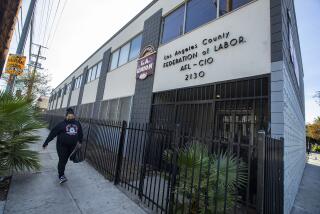Judge May Question Council on Remapping : Politics: Some members fear a ‘national embarrassment’ if they are questioned in court.
Adding a new legal chapter to a growing political controversy, a federal judge Wednesday said that he may question San Diego City Council members in court next week on how an embattled redistricting plan was developed.
In the second hearing on the matter in his courtroom in two days, U.S. District Judge John Rhoades said he may seek testimony from some council members Tuesday to determine whether they violated a settlement in a 1988 lawsuit filed by the San Diego County Chicano Federation challenging the constitutionality of San Diego’s electoral system.
Specifically, Rhoades plans to review whether the manner in which the council tentatively approved the redistricting plan Monday--only hours after it was publicized--effectively denied the Chicano Federation and other minority community representatives a meaningful role in its consideration, as guaranteed by the settlement.
Chagrined by the prospect of perhaps having to defend the legality of the council’s actions in court, several council members warned Wednesday that such a hearing could be, as one put it, a “national embarrassment for San Diego.”
“Personally, I’d be embarrassed to even be a part of a council that ran into this kind of problem,” said Councilman Ron Roberts, who voted against the plan approved Monday. “This could be one of those landmark stories that wouldn’t do much for our image.”
Wednesday’s court session was prompted by city attorneys’ admission to Rhoades that they had unintentionally misstated the council’s timetable for formal adoption of the plan to redraw council district boundaries during Tuesday’s hearing.
On Tuesday, Jack Katz, senior chief deputy city attorney, told Rhoades that the redistricting map will be formally introduced July 23 but later learned that that step is, in fact, scheduled to occur a week earlier, next Monday.
The earlier council hearing date meant that the council conceivably could have formally approved the redistricting plan before Rhoades had an opportunity to rule on the merits of the Chicano Federation’s complaints.
The Chicano Federation hopes to persuade Rhoades to overturn the redistricting map approved by Monday’s 5-4 council vote in favor of an alternative proposed by a citizens’ advisory committee that Latino activists argue better protects minority voting rights.
One of the Latino group’s major objections is that the council’s proposed boundaries would reduce the Latino population within the 8th District from the advisory board’s proposed 52.2% figure to 51%.
Chicano Federation leaders argue that the decrease, although small numerically, is politically crucial and would significantly dilute Latino clout at the polls, in part because of the Latino community’s traditional low voter turnout.
The five council members and others who support the revised map dispute that contention, arguing that the new plan would have only a negligible effect on Latinos’ voice in 8th District elections.
However, before Rhoades rules on the merits of that question--one that goes to the heart of the Chicano Federation’s original lawsuit--he must first decide Friday when to consider the issue.
In briefs filed late Wednesday, Chicano Federation attorney Patricia Meyer, calling Monday’s council action “a vital and important step in the adoption of the plan,” urged Rhoades to immediately intervene to protect the group’s overriding redistricting objectives.
Repeating the arguments he presented earlier in court, Katz countered in his own brief Wednesday that it would be premature for the judge to act on that request because the council has not taken final action on redistricting.
Monday’s vote, Katz contends, was only the first step toward the eventual passage of the redistricting measure, which could be amended before its final adoption, probably next month.
Whenever Rhoades decides to hear the case, a key question is whether the council’s action Monday violated the terms of last year’s agreement between the city and the Chicano Federation that settled the first phase of the group’s lawsuit.
Among other things, that agreement specifies that the plaintiffs “shall be notified of any proposed redistricting plans and shall be provided with an opportunity to be heard in a public forum concerning all redistricting proposals.”
Emphasizing that Chicano Federation officials were unaware of the revised map offered Monday by Councilman John Hartley until it was presented to the council, Meyer cites that scenario as evidence of the city’s “bad faith” and violation of the agreement.
However, Katz, reiterating that Monday’s vote was not definitive, argues that the Chicano Federation and others will have sufficient opportunity to comment on the plan--and, more importantly, to attempt to alter it to their liking--before its final adoption.
Besides reducing the percentage of Latino residents in the 8th District, Monday’s map also divides the high-growth communities in northern San Diego, most of which were contained in the 5th District under the advisory board’s plan, among three districts. The composition of several other districts also would be markedly changed, with some City Hall insiders estimating that the new map could change council representation for up to 300,000 San Diegans.
Rhoades’ indication about the questioning of council members came in response to Meyer’s request to take formal depositions from them about how the revised map was developed.
Saying that there may be too little time to go through that normally time-consuming and expensive process, Rhoades, wryly noting that he can “listen faster than I can read,” suggested that the interrogation be streamlined by having the council members appear in court for questioning.
Katz, though, contends that a “legislative privilege” in state and federal law could prohibit Rhoades from inquiring into the council members’ “thinking processes” and why they voted as they did.
More to Read
Sign up for Essential California
The most important California stories and recommendations in your inbox every morning.
You may occasionally receive promotional content from the Los Angeles Times.










